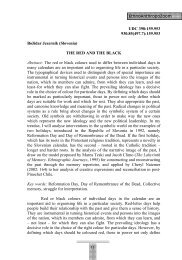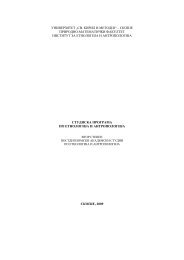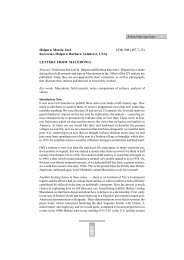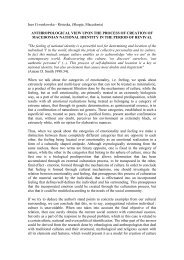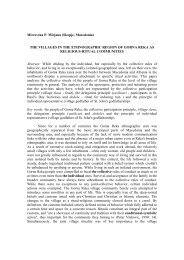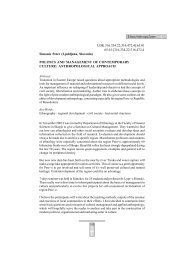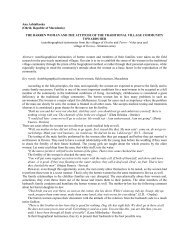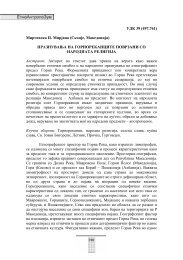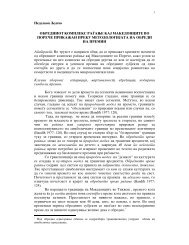Obrembski Jozef, Ritual and Social Structure in a Macedonian Village
Obrembski Jozef, Ritual and Social Structure in a Macedonian Village
Obrembski Jozef, Ritual and Social Structure in a Macedonian Village
You also want an ePaper? Increase the reach of your titles
YUMPU automatically turns print PDFs into web optimized ePapers that Google loves.
several days, the villagers unite <strong>in</strong> vary<strong>in</strong>g capacities <strong>in</strong> the performance of symbolic acts with one<br />
common <strong>and</strong> supreme referent: the world of supernatural entities <strong>and</strong> forces, believed to be at that<br />
time particularly active <strong>and</strong> therefore <strong>in</strong>strumental <strong>in</strong> controll<strong>in</strong>g the welfare (or the ill-fortune) of<br />
the group.<br />
One ritual for which the responsibility rests exclusively with tlie village men is a water<br />
consecration ceremony correspond<strong>in</strong>g to Epiphany. The ritual extends over three days, with an<br />
<strong>in</strong>terven<strong>in</strong>g "women's day" dedicated to the commeno ration of the dead. This rite st<strong>and</strong>s <strong>in</strong> the<br />
wliole of the yearly ceremonial cycle as the climax of all ritual activities. Never omitted or<br />
neglected, it is considered essential to the prosperity <strong>and</strong> successful life of the village.<br />
The ma<strong>in</strong> person <strong>in</strong> the ceremony is tlie village godfather, the kum. described by the villagers as<br />
"our village priest." The office is "elective" on a l<strong>in</strong>eage basis. It is assigned yearly <strong>in</strong> rotation to<br />
one of the tliree oldest l<strong>in</strong>eages, or kabile. Usually a man strong enough to st<strong>and</strong> the hardships of<br />
the ritual is designated for this function by his ability.<br />
The village kum acts as an <strong>in</strong>termediary between the local religious community <strong>and</strong> the supra-local<br />
ecclesia, The ritual starts with the consecration of the water by tlie parish priest at the parish<br />
church, where all the village kums from the surround<strong>in</strong>g area gather. Each kum carries (9) his<br />
village cross, which is both a symbol of his village's sacral unity (<strong>and</strong> of the kum's dignity) <strong>and</strong> of<br />
fertility, health <strong>and</strong> plenty which, through the performance of the ritual, are to be delivered to t<strong>in</strong>e<br />
village.<br />
On his return home the kum walks about the village <strong>and</strong>, with appropriate bless<strong>in</strong>gs, spr<strong>in</strong>kles the<br />
homesteads. build<strong>in</strong>gs, fields, meadows, stables, huts <strong>and</strong> shelters, orchards <strong>and</strong> beehives, <strong>and</strong><br />
particularly the villagers <strong>and</strong> all their livestock, chant<strong>in</strong>g: "As many children, as many drops. As<br />
drops are many, so may be calves, lambs <strong>and</strong> kids. So many apples, so many bees. Let there be<br />
health, prosperity <strong>and</strong> plenty. For everyone <strong>and</strong> everyth<strong>in</strong>g. Amen. " All the households are visited,<br />
<strong>and</strong> at each the kum is expected to be generous with his bless<strong>in</strong>gs. Noth<strong>in</strong>g alive which is valued<br />
by the peasant may be overlooked. Every member of the household must be mentioned by his<br />
personal name <strong>and</strong> <strong>in</strong>cluded <strong>in</strong> the bless<strong>in</strong>gs.<br />
At the nightly receptions held at each house follow<strong>in</strong>g the rite the kum acts not as a guest, but as if<br />
he were the actual host. Accompanied by his acolytes he enters each house without knock<strong>in</strong>g at the<br />
door, sits down to the prepared feast without wait<strong>in</strong>g for an <strong>in</strong>vitation, <strong>and</strong>, without <strong>in</strong>vitation,<br />
starts eat<strong>in</strong>g <strong>and</strong> dr<strong>in</strong>k<strong>in</strong>g, offer<strong>in</strong>g toasts to the health <strong>and</strong> prosperity of the head of the house <strong>and</strong><br />
Ins family. Only men participate <strong>in</strong> this reception. The same ceremony is repeated at each house,<br />
with an <strong>in</strong>creas<strong>in</strong>g number of participants, s<strong>in</strong>ce the men of the visited house then jo<strong>in</strong> the kum's<br />
party (10) The next day is a day of respite for men. It is also a day of mourn<strong>in</strong>g for the village, a<br />
memorial day for their dead. All villagers participate <strong>in</strong> the ceremonies, but articulate ritual roles<br />
are performed by women only. The day is called "women's little waters" as dist<strong>in</strong>guished from the<br />
third day "men's little waters."<br />
The third day of tills cycle, at which the ceremony comes to a close, ends <strong>in</strong> feast<strong>in</strong>g <strong>and</strong> danc<strong>in</strong>g.<br />
As with all such celebrations, the festivity takes place at the village graveyard. The ma<strong>in</strong> ritual<br />
consists of the <strong>in</strong>auguration of a new kum <strong>and</strong> the transfer to him of the village cross. This starts<br />
with a procession around the church, led by the retir<strong>in</strong>g kum, to the accompaniment of girls' songs.<br />
Then, <strong>in</strong> a spacious vestibule <strong>in</strong> front of the t<strong>in</strong>y church, the village cross is h<strong>and</strong>ed over by the old<br />
kum to his successor, to be kept until the next year's rite. At this time, pieces of str<strong>in</strong>g, by which



